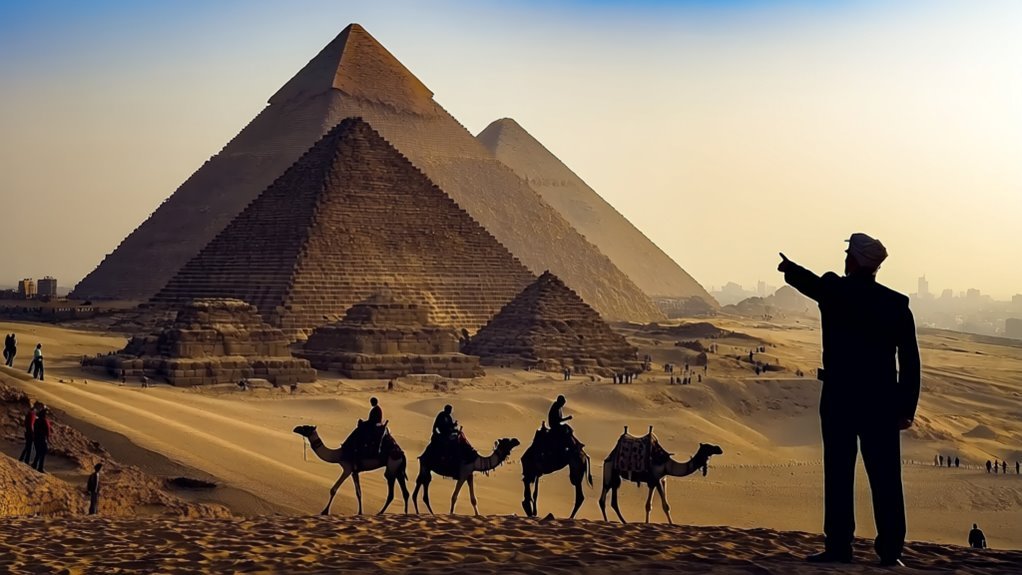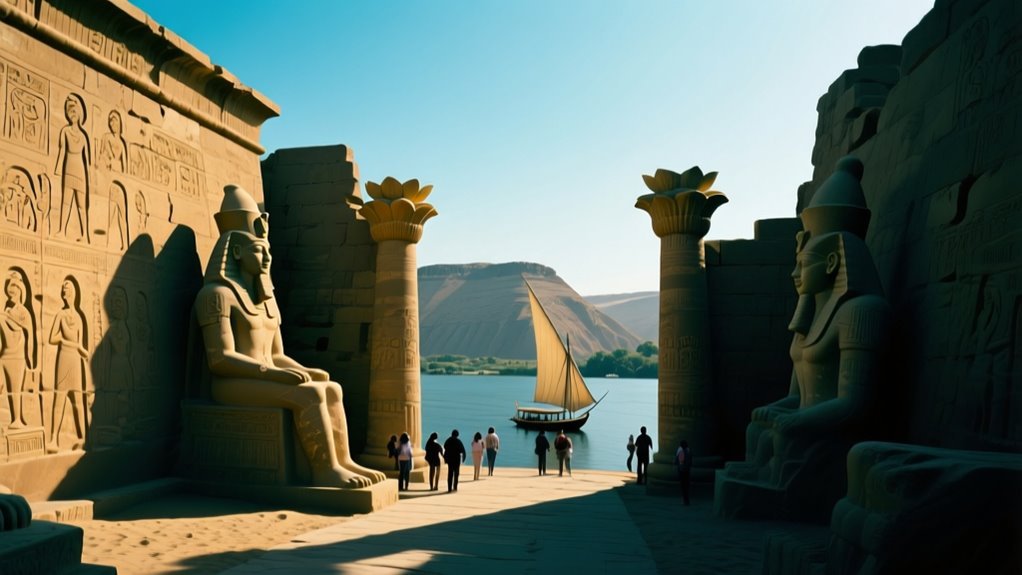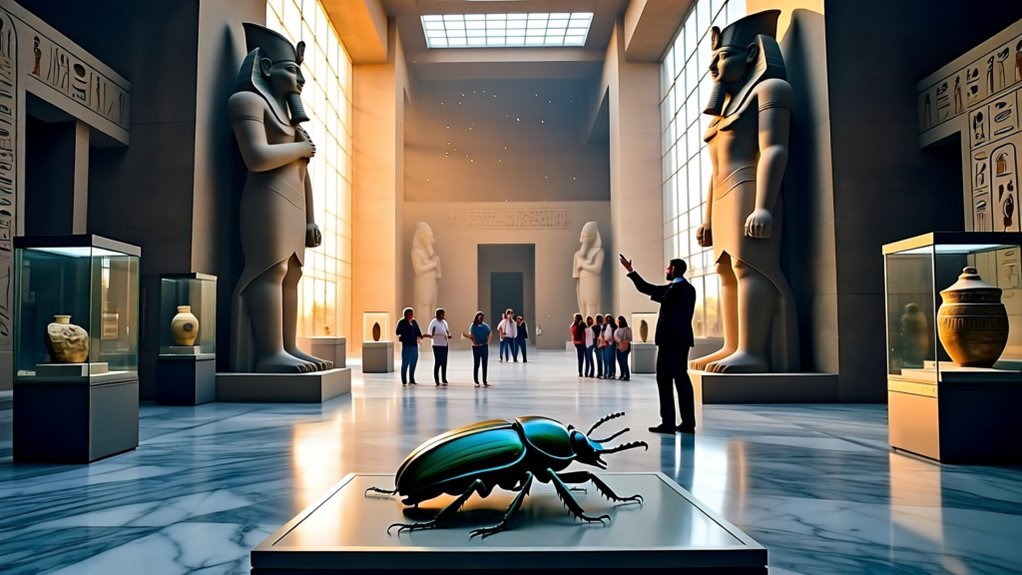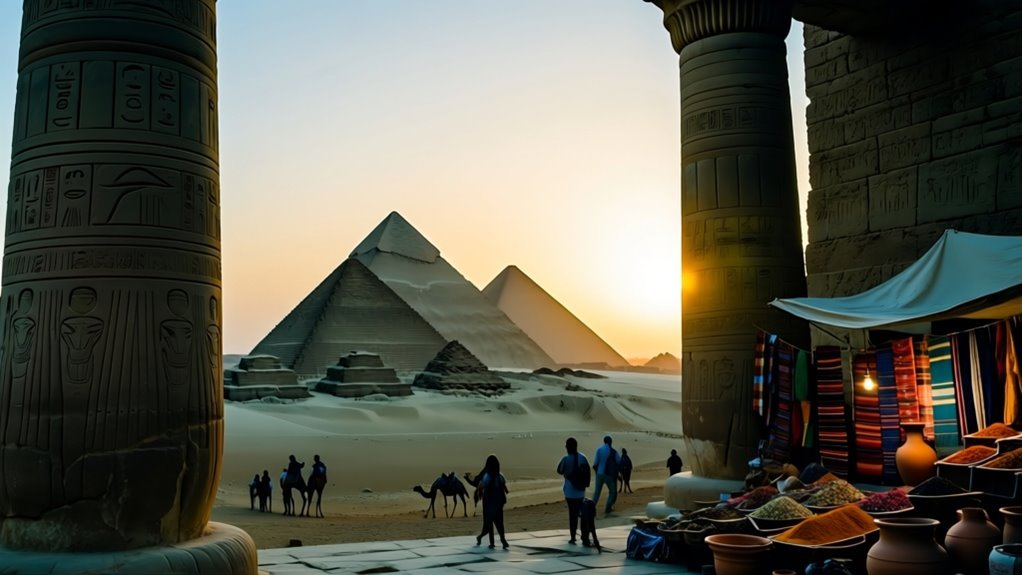You can explore the Great Pyramids and the Great Sphinx of Giza, marveling at their ancient engineering and symbolism. Visit Ancient Thebes to see Karnak and the Valley of the Kings with intricate tombs.
The Grand Egyptian Museum near Giza offers over 100,000 artifacts including King Tut’s treasures. Don’t miss the relocated Abu Simbel Temples with their solar alignments or Kom Ombo’s unique twin temples.
More ancient wonders and preservation stories await your discovery.
Key Takeaways
- Explore the Great Pyramids of Giza and the Great Sphinx, marveling at their ancient engineering and iconic symbolism.
- Visit the Valley of the Kings to see elaborately decorated royal tombs from the New Kingdom era.
- Tour the Abu Simbel Temples, renowned for their colossal statues and solar-aligned sanctuaries.
- Discover Karnak Temple Complex and Hatshepsut’s mortuary temple for impressive religious architecture and historical insights.
- Experience the Grand Egyptian Museum near Giza, showcasing over 100,000 artifacts and ancient Egyptian civilization history.
Explore the Great Pyramids of Giza

When you explore the Great Pyramids of Giza, you’re engaging with an architectural marvel built over 4,500 years ago. The Great Pyramid, completed around 2560 BCE after 26 years of construction, originally stood over 481 feet tall, now reduced to about 450 feet due to erosion.
Its massive stone blocks average over two tons each, with some weighing up to 15 tons. These pyramids represent an evolution from earlier step pyramids to smooth-sided structures, demonstrating the advanced engineering skills of the ancient Egyptians. Approximately 2.3 million large stones were used in the construction, totaling about 6 million tonnes.
Constructed as royal tombs within mortuary complexes, they showcase precise architectural planning and cultural significance. By studying these structures, you gain insight into ancient technology and the societal importance placed on honoring pharaohs and ensuring their journey to the afterlife. Visitors can experience these treasures as part of a private tour of Egyptian Pyramids included in many travel packages.
Visit the Great Sphinx of Giza
Although overshadowed by the towering pyramids, the Great Sphinx of Giza commands attention through its impressive scale and enigmatic presence. Carved from a single limestone bedrock around 4,500 years ago during Pharaoh Khafre’s reign, it measures about 73 meters long and rises 20 meters high.
When you visit, you’ll notice its blend of a lion’s body with a human head wearing the Nemes headdress, symbolizing strength and royal intellect. The Sphinx aligns with nearby pyramids and likely represents Khafre or a deity like Horus, reflecting its religious significance. It was carved from a large limestone ridge and likely took around three years to complete using copper tools and a workforce of about 100 men construction process. It remains one of the most iconic monuments included in many Egypt tours that also feature the Pyramids of Giza.
Although erosion and damage have altered its features, ongoing restorations preserve this monumental statue. Approaching it, you encounter a blend of artistry, astronomy, and historical mystery unique to ancient Egypt’s Old Kingdom period.
Discover the Ancient Thebes and Surrounding Sites

When you explore Ancient Thebes, start with the Karnak Temple Complex, which spans over 5,000 square meters. It showcases monumental pylons and the Great Hypostyle Hall. This complex was originally started in the Middle Kingdom under Senusret I and expanded mainly during the New Kingdom, making it the second largest religious site.
Then, cross to the west bank to examine the Valley of the Kings, a vast necropolis housing royal tombs adorned with intricate wall paintings. Similar to this ancient site, Beijing offers a Full-Day Olympic Sites & Great Wall tour that highlights both historic and modern landmarks.
Don’t miss the surrounding mortuary temples, like Hatshepsut’s at Deir el-Bahri, which feature distinctive architecture and detailed relief carvings.
Karnak Temple Complex
As you explore the Karnak Temple Complex, you’ll encounter a sprawling religious site dedicated mainly to the god Amun-Re. It features monumental pylons, expansive courtyards, and the architectural marvel of the Great Hypostyle Hall.
This hall contains 134 sandstone columns, the tallest reaching 20 meters. They’re arranged to evoke ancient Egyptian cosmology, symbolizing Upper and Lower Egypt.
The pylons serve as gateways, adorned with hieroglyphic reliefs narrating religious and royal history. Smaller temples within honor deities Mut and Khonsu, forming a triad.
The temple layout reflects the concept of *zep tepi*, guiding worshippers through ascending sacred spaces to the divine.
Constructed over centuries from the Old Kingdom onward, Karnak embodies evolving religious practices and pharaonic ambition. It emphasizes ritual procession and symbolic architecture that shaped ancient Egyptian worship. The complex covers about 250,000 sq meters, making it one of the largest religious sites ever built in Thebes.
Valley of the Kings
Because the Valley of the Kings served as the exclusive royal burial ground during Egypt’s New Kingdom, it represents a critical shift in funerary practices from visible pyramid tombs to concealed rock-cut chambers designed to protect the deceased from grave robbers.
You’ll find that tombs here evolved from simple pits to complex corridors and multiple chambers, often decorated with hieroglyphs illustrating the pharaoh’s journey to the afterlife.
The valley’s natural seclusion and resemblance to a pyramid shape enhanced its security and symbolic power. This rock-cut necropolis was used by rulers starting with the reign of Thutmose I, marking Egypt’s resurgence and the preference for underground burial during the New Kingdom.
Discoveries such as Tutankhamun’s intact tomb reveal the wealth and craftsmanship involved.
Organized teams from Deir al-Medina built these tombs, balancing secrecy with elaborate religious iconography.
While most tombs were looted, the Valley remains a treasure trove for studying New Kingdom burial rites and royal beliefs about death and immortality.
Mortuary Temples Visit
Beyond the hidden resting places of pharaohs in the Valley of the Kings, Ancient Thebes offers mortuary temples that played a pivotal role in honoring the deceased rulers’ divine presence and ensuring their ongoing worship. Visiting these temples reveals their function as cult centers where priests performed daily rites to sustain the king’s *ka*. These temples were often called “mansions of millions of years” because of their grandeur and enduring religious importance.
Architecturally, they feature entrance pylons, multiple courtyards, and grand causeways linking to valley temples. Temples like Amenhotep III’s symbolize divine rulership and cosmic order. Preservation challenges persist due to natural damage and tourism impact.
Key highlights include:
- Priestly rituals honoring the pharaoh’s spirit
- Ritual objects like the Amun boat linked to festivals
- Multi-level terraces and symbolic architectural designs
- Representation of pharaohs as living gods
- Modern restoration efforts safeguarding these sites
Tour the Grand Egyptian Museum

When you visit the Grand Egyptian Museum, you’ll explore the world’s largest archaeological museum, sprawling across 120 acres near the iconic Pyramids of Giza. Situated just 2 kilometers northwest of the Giza pyramid complex, this vast museum covers 81,000 square meters and houses over 100,000 artifacts spanning 7,000 years of history. As part of the ambitious Giza 2030 master plan, the museum integrates cultural preservation with comprehensive site development initiatives, enhancing the visitor experience within the region’s heritage landscape.
Designed by Heneghan Peng Architects, its pyramid-inspired structure offers controlled lighting and protection from vibrations, enhancing artifact preservation. You’ll find exhibits ranging from daily life items to royal treasures, including the entire King Tutankhamun collection and a monumental statue of Ramses II. The museum also complements other historic sites such as the Pyramids of Giza and the Sphinx, which remain key attractions in Cairo.
Although partially open since October 2024, full access is delayed until late 2025. This museum consolidates Egypt’s archaeological heritage, promising an immersive, educational experience deeply rooted in Egypt’s cultural legacy.
Experience the Abu Simbel Temples
You’ll be struck by the sheer scale and precision of the Abu Simbel temples, carved directly into a sandstone cliff to honor Ramses II.
Take note of how the temples were expertly relocated in the 1960s, a complex engineering project led by UNESCO to safeguard them from rising waters caused by the Aswan High Dam. This incredible feat of preservation is one of the most significant cultural heritage efforts in modern history.
This preservation effort guarantees you can still experience these iconic architectural masterpieces firsthand.
The temples also feature a fascinating solar alignment that illuminates the statues inside twice a year, showcasing ancient Egyptian astronomical knowledge.
Architectural Marvels Overview
Although the Abu Simbel Temples were carved directly into sandstone cliffs thousands of years ago, their colossal statues and intricate interiors continue to captivate visitors with striking political, religious, and astronomical significance.
As you explore, you’ll notice the monumental façade adorned by four 20-meter statues of Ramesses II, symbolizing his divine and political power.
Inside, chambers rich with carvings document Ramesses’ victories and religious devotion. These temples were carefully relocated in the 1960s to prevent submersion during the creation of Lake Nasser, showcasing an extraordinary UNESCO preservation effort.
Remarkably, twice a year, sunlight penetrates the sanctuary, revealing statues aligned with key annual events.
Nearby, a smaller temple honors Queen Nefertari, emphasizing her royal stature.
Key features you’ll encounter include:
- Four colossal seated statues of Ramesses II on the Great Temple façade
- Interior chambers with detailed carvings depicting battles and gods
- Sunlight aligning to illuminate the sanctuary twice annually
- Hypostyle hall supported by eight Osiris pillars
- Nearby small temple dedicated to Queen Nefertari
Relocation and Preservation Efforts
Because the construction of the Aswan High Dam threatened to submerge the Abu Simbel Temples in the 1960s, an extraordinary international effort led by UNESCO successfully relocated these ancient monuments. Originally built by Ramses II around 1244 B.C. to honor the gods and demonstrate divine authority, these temples represent a pinnacle of Egyptian architectural achievement.
Starting in 1964 and completing in 1968, over 2,000 workers dismantled the sandstone temples into 20 to 30-ton blocks using advanced pneumatic tools supplied by Atlas Copco and Sandvik.
The blocks were precisely reassembled at a carefully chosen higher site, maintaining their original astronomical alignment and preserving the sunlight illumination effect twice yearly. This careful reassembly preserved the temples’ unique solar alignment, ensuring that the inner sanctuary remains illuminated on specific days, highlighting their cultural and religious significance.
This massive project relocated over 330,000 cubic meters of stone, balancing engineering challenges like porous sandstone fragility and environmental protection against flooding and erosion.
Funded globally, this collaboration saved a critical cultural heritage site, showcasing how innovation and international cooperation can secure history for future generations.
Wander Through Kom Ombo and Other Unique Temples
When you explore Kom Ombo Temple, you encounter a rare architectural marvel featuring a perfectly symmetrical double structure dedicated to two gods. Sobek and Haroeris each have their own mirrored halls, sanctuaries, and entrances split by a central axis of symmetry.
Constructed mainly from limestone during the Ptolemaic dynasty, its detailed hieroglyphic reliefs depict religious ceremonies and divine myths. The temple was built between 180 BC and 145 BC, showcasing the architectural style of that era. Visitors to historical sites in the region often appreciate the blend of cultural influences visible in these ancient structures.
Crafted from limestone in the Ptolemaic era, its hieroglyphs illustrate sacred rites and mythic tales.
This temple uniquely combines artistry and spirituality with a layout emphasizing cosmic balance.
As you wander Kom Ombo, note these features:
- Twin temples for Sobek, the crocodile god, and Haroeris, the falcon-headed sky god
- Hypostyle halls with palmiform columns inscribed in hieroglyphs
- Sacred sanctuaries and birth houses in each half
- Scenes of Ptolemaic priests conducting rituals
- Evidence of expansions by Ptolemaic rulers and Roman emperors
This site remains a compelling example of Egypt’s complex religious architecture.
Uncover History at the Valley of the Kings and Memphis
If you want to explore deep into Egypt’s royal and administrative past, the Valley of the Kings and Memphis offer distinct yet complementary insights.
At the Valley of the Kings, you’ll find nearly 63 tombs from New Kingdom pharaohs, queens, and officials, including the nearly intact treasures of Tutankhamun. The tombs’ intricate carvings and protected chambers reveal sophisticated burial practices and religious symbolism. This royal necropolis was carved into limestone cliffs on the west bank of the Nile, emphasizing both protection and spiritual symbolism. Visitors can also enjoy guided tours and cultural insights, enhancing the historical experience.
In contrast, Memphis served as the Old Kingdom’s political and religious capital near the Nile Delta. Dedicated to Ptah, Memphis thrived as a cultural hub before Thebes and Alexandria rose to prominence.
Together, these sites highlight Egypt’s evolving power centers and spiritual life across millennia. Their global significance is underscored by UNESCO World Heritage designations and ongoing archaeological research.
Frequently Asked Questions
What Is the Best Time of Year to Visit Historical Egypt?
The best time to visit historical Egypt is between October and April when temperatures are comfortable for exploring outdoor sites.
Avoid the extreme summer heat, especially June to August, as it can top 38°C.
December and January offer sunny days around 20-25°C but bring larger crowds and higher prices.
For a balance, consider November to February for warmth or March-April to enjoy fewer tourists while still pleasant weather.
Are There Guided Tours Available in English?
Yes, you’ll find many guided tours available in English, led by expert Egyptologists who provide thorough explanations of ancient Egyptian history and architecture.
These tours often include multi-language options but primarily cater to English-speaking visitors.
You can customize private tours with English guides to suit your pace and interests.
Plus, cultural activities are typically conducted in English, ensuring you get an immersive and understandable experience throughout your visit.
What Safety Precautions Should Tourists Take When Visiting These Sites?
You should know that pickpocketing spikes by up to 30% in crowded tourist areas, so stay vigilant and keep your belongings secure.
Always use guided tours to navigate security checks and engage with tourist police if needed; they’re trained to assist you.
Carry travel insurance covering unexpected events, and respect local customs to avoid unwanted attention.
Stay updated with local advisories and use reputable transportation for safer travel around historical sites.
How Accessible Are These Sites for Travelers With Mobility Issues?
You’ll find accessibility varies widely across Egypt’s sites.
Kom Ombo Temple and the Cairo Tower offer smooth, wheelchair-friendly access.
Some tombs in the Valley of the Kings have step-free pathways, but most pyramids limit interior access due to narrow passages.
Museums like the Egyptian Museum have ramps and elevators, while outdoor sites like Memphis and Saqqara pose challenges with sandy terrain.
Planning tailored tours and accessible transport helps you navigate these differences effectively.
Can I Take Photographs Inside the Tombs and Temples?
You can take photographs inside many tombs and temples without a permit or fee, but some sites still restrict photography, especially for professional use or large equipment.
Flash is usually prohibited to protect delicate art, and some locations ban photos altogether.
Always check on-site rules, as they vary. Respect local laws by obtaining consent before photographing people.
Avoid sensitive areas like military sites.
Confirm permissions with guards or staff before shooting.
Conclusion
You might think history’s best kept secrets are buried, but in Egypt, they’re standing tall—pyramids, temples, and statues that have defied time.
As you explore, it’s ironic how these ancient marvels, built thousands of years ago, still overshadow modern wonders.
So, while you’re glued to your screens, remember: here, history isn’t just remembered. It’s experienced firsthand in vivid detail, waiting for you to access its timeless stories.


0 Comment